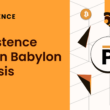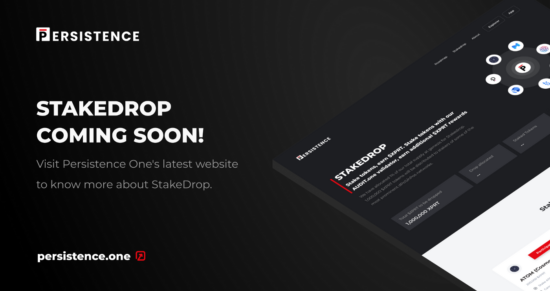Note: Persistence has pivoted to liquid staking and building DeFi primitives to increase the utility for staked assets. This article is only for archive purposes.
(Visit here to read our latest blogs)
The time has almost arrived. We’ve been meticulously planning the mechanism and execution of an innovative initiative to provide the crypto community with access and exposure to XPRT (Persistence’s native token).
It’s called StakeDrop, and it’s emerging on the horizon. Read the full details below.
TL;DR
- StakeDrop is a distribution mechanism which allows holders of PoS network tokens to acquire XPRT simply by staking on their favorite networks.
- Networks included in the StakeDrop campaigns are: Cosmos Network, Terra, Kava Labs, IRISnet, Polkadot, Matic Network and Tezos.
- 1% of the total XPRT token supply (1,000,000 XPRT) is allocated for StakeDrop rewards.
- Reward amounts for specific participants depend on a variety of factors, including which network/s they are staking on, whether they are delegating to an AUDIT.one validator (higher rewards) or a different validator, and the length of their participation in each campaign.
- The first StakeDrop campaign will be on Cosmos Network, beginning October 26th.
What is StakeDrop, Anyhow?
StakeDrop is a token distribution mechanism that allows token holders of some of the most prominent Proof-of-Stake (PoS) networks to get exposure to XPRT tokens (Persistence tokens). Essentially, StakeDrop is a way for supporters of PoS blockchains to receive XPRT tokens as rewards simply by staking on their favourite networks.
Persistence will be running StakeDrop campaigns on the following networks:
Token holders of these networks can stake their native assets with any active validator to earn XPRT tokens, in addition to the current network staking rewards they’re earning.
There will be additional incentives for token holders to delegate their tokens to our AUDIT.one validator nodes (AUDIT.one is the staking arm of Persistence).
1% of the total XPRT token supply (1,000,000 XPRT) is allocated for StakeDrop rewards. Every unique participating wallet can earn up to a maximum of 5,000 XPRT tokens (max 5000 XPRT tokens for each ERC20 wallet address). This is to prevent (as far as possible) whales from dominating the rewards allocation, helping to ensure a wide distribution of XPRT.
Before we dive deeper into StakeDrop, let’s learn more about the asset on offer, XPRT.
XPRT Token: Driving the Persistence Ecosystem
XPRT is Persistence’s native token. It will carry a variety of use cases within the Persistence ecosystem:
- Staking: Participating in staking to contribute to network security. Stakers on Persistence will be rewarded for their participation with staking rewards in the form of XPRT.
- Community governance: XPRT token holders will be able to propose and vote on changes to different factors relating to the Persistence mainchain.
- ‘Work’ token: As a work token, XPRT also accrues value in direct correlation to increased financial activity within Persistence’s ecosystem dApps.
XPRT tokens will initially be launched as a standard ERC20 token.They will be swapped with our Tendermint-based native Persistence token following the launch of the Persistence mainnet.
So why are we distributing XPRT, you might be wondering. It’s simple — mutual benefit.
Benefits of StakeDrop: A Win-Win-Win
The Persistence StakeDrop is designed in such a way that it benefits all parties involved.
The three key parties are:
- Persistence
- Delegators or StakeDrop participants
- Partner networks
Persistence
Our StakeDrop is a highly targeted method of ‘airdrop’, allowing us to distribute our tokens to the staking community whilst also facilitating distributed community governance, once the Persistence mainnet is live.
- Stakers are long-term token holders, not merely speculators. This StakeDrop gives us the perfect opportunity to ensure a wider distribution of XPRT tokens amongst individuals familiar with staking, allowing us to bootstrap network security prior to launching the Persistence mainnet.
- The wide distribution of XPRT will also provide us with a broad base of token holders who will be able to participate in community governance of the Persistence mainchain.
Delegators or StakeDrop Participants
Key benefits for delegators participating in the StakeDrop are:
- There’s no need for liquidation of current holdings to get exposure to XPRT tokens. Long-term holders in dPoS/nPoS network tokens can stake their assets to receive XPRT token while retaining their original holdings.
- (Near) zero principal risks. The StakeDrop is one of a few ways people can get exposure to a promising project like Persistence without any principal risk. The only risk delegators undertake is that of the delegators’ validator nodes getting slashed for downtime, or double signing (this is a risk of the staking mechanism in general).
- It’s non-custodial in nature. Delegators retain custody of staked assets at all times (unlike the Edgeware Lockdrop where assets were locked up in a smart contract).
Partner Networks
Benefits for networks included in StakeDrop campaigns are two-fold:
- The ability for token holders to earn XPRT tokens at near-zero principal risk, incentivizes token holders to stake their assets on our partner networks, thus strengthening the security of these networks (the higher the staking ratio, the higher the security).
- Campaigns such as these reward long-term token holders and stakers of our partner networks by giving them exposure to new projects like Persistence without any complications. This is an additional incentive, along with staking rewards, for being a staker on the network.
How Will StakeDrop Work?
Registration
All stakers on the seven aforementioned networks will be eligible to participate in the StakeDrop, but you must register your participation with a couple of simple steps.
Step 1: Stake your tokens on your chosen network.
Step 2: Provide proof that you are staking and provide your ERC20 wallet address (where you will be receiving your StakeDrop rewards) by sending a ‘Magic Transaction’ to the address listed on the Persistence website. More details of the process can be found here.
Once you have completed the Magic Transaction, you’re all set! You are now an active participant in the StakeDrop campaign and you will start earning XPRT rewards.
Notes:
- Registration via the Persistence website will be available shortly before the launch of each StakeDrop campaign.
- You must be staking on-chain to be eligible (staking via exchanges does not count). This is to ensure accurate data can be retrieved from each chain.
Rewards Allocation
The total number of XPRT available during each campaign will vary from network to network.
The mechanism is designed in such a way that the number of XPRT tokens dropped each day during each campaign increases linearly, until a certain amount of days have passed. From then on, a fixed number of XPRT tokens are dropped each day which will be distributed amongst all participants of the StakeDrop.
In the example StakeDrop campaign of Cosmos Network above, the campaign period is 30 days. The daily dropped tokens increases linearly until day 21, and remains constant until the final day of the campaign.
The amount of XPRT allocated to each participant is dependent on a number of factors, including:
- The total number of XPRT allocated to each network’s StakeDrop campaign.
- The total number of XPRT dropped on a given day (based on the drop schedule, as described above).
- The total number of assets being staked by participants of each campaign at any one time (Participants will be sharing the rewards pool relative to the daily weightage of their stake).
- Whether they are delegating to an AUDIT.one validator node or a different validator (see below for details).
You can find more details, including formulas, in our detailed documentation here.
For every StakeDrop campaign, there are two ways a delegator can earn XPRT tokens:
- Delegate your tokens to any active validator on the network.
- Delegate your tokens solely to the AUDIT.one validator on the network (AUDIT.one will have an active validator node on all participating networks).
This means there are two rewards pools per campaign. All participants are rewarded through the Network Rewards Pool. There’s a separate AUDIT.one Rewards Pool which incentivizes delegation to our AUDIT.one validator. As a result, delegators to AUDIT.one receive their share of rewards from the Network Rewards Pool as well as the AUDIT.one Rewards Pool.
Therefore, the total rewards for AUDIT.one delegators = rewards from the Network Rewards Pool + rewards from the AUDIT.one Rewards Pool.
Delegators to all other validators will only receive the base rewards from the Network Rewards Pool, and not the additional bonus from the Audit.one Rewards Pool.
NOTE: The magic tx should be ‘SendCoin’ tx only with the MEMO containing ERC20 wallet address. For example on cosmoshub-3 (and for all cosmos based chains), tx should be ‘bank/transfer’ (usual ‘SendCoin’) (msgType: ‘cosmos-sdk/MsgSend’), NOT Multi-Send tx.
Timeline
The first of seven StakeDrop campaigns will be on Cosmos Network, and will begin on October 26th, 2020.
The order and dates of the six other network campaigns is not yet set in stone; we will provide updates with further details, along with details regarding each specific StakeDrop, as we move forward.
XPRT tokens allocated via the StakeDrop campaigns will be distributed over a period of 12 months following the token generation event. All tokens earned via StakeDrop have a six-month lockup period and will be linearly vested over the next six months.
Much More than an Airdrop
Airdrops are so 2017. StakeDrop has been meticulously designed to be much more than a conventional airdrop; it’s an experience. StakeDrop is a distribution mechanism for XPRT that benefits all parties involved, whilst providing an engaging experience for StakeDrop participants.
Not only does StakeDrop encourage the crypto community to become more integrated in the mechanics of the blockchain ecosystem by learning how to stake their assets on-chain, but it also incorporates intricate game theory, for those who are up to the challenge of maximizing their XPRT allocation.
Participants who want to obtain the most XPRT possible must consider a number of factors during StakeDrop, including: whether to switch between networks once a new StakeDrop campaign begins; the total XPRT allocated for each campaign; the number of XPRT dropped on each day; the number of participants of each active campaign at any given time, and much more.
Catering to both long-term stakers on the participating networks who simply want to secure some XPRT for their ongoing staking efforts, and those who are up for the challenge of tackling the StakeDrop game theory, StakeDrop enables the wider PoS network communities to attain XPRT in a way that benefits all parties.
Get your ATOM prepared for our first StakeDrop campaign on the Cosmos Network, beginning on October 26th. Further details will be shared as the date approaches.
Dive into the deeper details of StakeDrop by reading our full documentation here: https://persistence.one/stakedropinfo.pdf
Are you ready for StakeDrop? We certainly are 😎
About Persistence
Persistence is a Tendermint-based, specialised Layer-1 network powering an ecosystem of DeFi applications focused on unlocking the liquidity of staked assets.
Persistence facilitates the issuance and deployment of liquid-staked stkASSETs, allowing users to earn staking rewards while participating in DeFi primitives, such as lending/borrowing and liquidity provisioning on DEXs.
Persistence aims to offer a seamless staking and DeFi experience for PoS (Proof-of-Stake) users and enable developers to build innovative applications around stkASSETs.
Join Our Movement
Twitter | LinkedIn | Telegram | YouTube | Reddit | [email protected]





